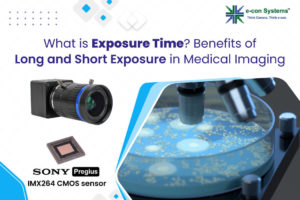Medical Applications for Embedded Vision
Embedded vision has the potential to become the primary treatment tool in hospitals and clinics
Embedded vision and video analysis have the potential to become the primary treatment tool in hospitals and clinics, and can increase the efficiency and accuracy of radiologists and clinicians. The high quality and definition of the output from scanners and x-ray machines makes them ideal for automatic analysis, be it for tumor and anomaly detection, or for monitoring changes over a period of time in dental offices or for cancer screening. Other applications include motion analysis systems, which are being used for gait analysis for injury rehabilitation and physical therapy.
Video analytics can also be used in hospitals to monitor the medical staff, ensuring that all rules and procedures are properly followed. For example, video analytics can ensure that doctors “scrub in” properly before surgery, and that patients are visited at the proper intervals.
What are the primary vision products used in medical systems?
Medical imaging devices including CT, MRI, mammography and X-ray machines, embedded with computer vision technology and connected to medical images taken earlier in a patient’s life, will provide doctors with very powerful tools to help detect rapidly advancing diseases in a fraction of the time currently required. Computer-aided detection or computer-aided diagnosis (CAD) software is currently also being used in early-stage deployments to assist doctors in the analysis of medical images by helping to highlight potential problem areas.

Multi-camera 3D Scanning in Medical Applications Using Embedded Cameras
This blog post was originally published at TechNexion’s website. It is reprinted here with the permission of TechNexion. 3D scanning finds applications in multiple domains such as textile design, 3D printing, home remodeling, virtual reality, manufacturing, etc. Medical science hugely benefits from camera-enabled 3D scanning given that it is a non-invasive technique. 3D scanning is

Digi International to Unveil the New Digi ConnectCore MP25 System-on-module for Next-gen Computer Vision Applications at Embedded World 2024
Versatile, wireless and secure system-on-module based on the STMicroelectronics STM32MP25 processor improves efficiency, reduces costs and enables edge processing for innovative new devices MINNEAPOLIS, April 4, 2024 – Digi International (NASDAQ: DGII, www.digi.com), a leading global provider of Internet of Things (IoT) connectivity products and services, is poised to introduce the wireless and highly power-efficient

A One-stop Solution for Digital Skin Analyzers
This blog post was originally published at e-con Systems’ website. It is reprinted here with the permission of e-con Systems. In this blog, we are exploring types of skin analyzers prevalent in the industry and giving insights on the kind of cameras that should be used to get the best results. In the skincare industry,

AI, Telehealth and Communications: Digital Healthcare
Software reading scans and online management of mental health are examples of digital healthcare that keep up with the modernization of the world, where efficiency and patient satisfaction are two key benefits. The weight of increasing demand for services could be lifted as more options become available for patients to seek treatment, and communication across

Edge AI in Medical Applications
This blog post was originally published at Digica’s website. It is reprinted here with the permission of Digica. A practical use for object detection based on Convolutional Neural Networks is in devices which can support people with impaired vision. An embedded device which runs object-detection models can make everyday life easier for users with such

Fixed-focus vs. Autofocus Lenses: How to Choose the Best Lens for Your Application
This blog post was originally published at e-con Systems’ website. It is reprinted here with the permission of e-con Systems. In this blog, you’ll learn about these two lens types with key insights into their attributes and best-use scenarios in the world of embedded vision. Embedded vision systems rely heavily on the capabilities of their

A Digital Health Progress Report and the Future of Healthcare Delivery
Healthcare systems around the world are being put under increasing strain every year. Key challenges they face include overburdened medical staff and a steady rise in patients with chronic health conditions that require high levels of care. Digital health has long been proposed as a solution to both problems, but the adoption of digital health

Digital Health and Artificial Intelligence 2024-2034: Trends, Opportunities, and Outlook
For more information, visit https://www.idtechex.com/en/research-report/digital-health-and-artificial-intelligence-2024-2034-trends-opportunities-and-outlook/985. Telehealth, telemedicine, remote patient monitoring, consumer health wearables, digital therapeutics, & artificial intelligence in medical diagnostics Over the past decade, digital health and artificial intelligence (AI) have changed the delivery of healthcare. With more health data collected today than ever before, companies around the world are developing digital technologies, including

A Visual Quality Control Solution for Pharma Industry Inspection Machines
This blog post was originally published at Silo AI’s website. It is reprinted here with the permission of Silo AI. Together with Körber, Silo AI has developed a visual quality solution for inspection machines to control the quality of Covid19 vaccine ampoules. The international technology group Körber and Silo AI, one of the largest private

What is Exposure Time? The Benefits of Long and Short Exposure in Medical Imaging
This blog post was originally published at e-con Systems’ website. It is reprinted here with the permission of e-con Systems. In this blog, we’ll explore how long and short exposure times can benefit medical and fluorescent imaging. We will also delve into the dynamic capabilities offered by Sony Pregius IMX264 CMOS sensor-based camera. Medical imaging

